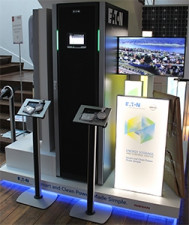
Automotive manufacturer Nissan, in partnership with power management company Eaton, have introduced the xStorage, a stationary energy storage and control centre technology used either in the home, in commercial buildings or industrial sites.
According to Eaton, the xStorage is a fully integrated and industrialised energy storage system used to enable consumers to manage peak power demand, manage off grid situations and to manage black outs in the electrical grid by integrating renewable energy directly into the home power supply system or in a commercial facility.
The storage device gives the consumer complete control of how they can use stored energy, helping them improve usage of renewable energy, while providing backup supply and continuity during power fluctuations, says Eaton.
Jonathan Hart, senior manager of Corporate Communications at Eaton EMEA, says the partnership aims to combine Nissan and Eaton's expertise in lithium-ion batteries and power electronics to introduce cost-competitive second-life energy storage and control technologies to the market.
"The partnership was initially introduced four years ago when Nissan and Eaton joined forces on a different project - the European Union Project, which focused on the GreenDataNet initiative, which looks at how to drive better energy efficiency and energy storage within data centres.
Following that project, he adds, there was a huge potential for further introduction of new technologies and research development which could make a huge difference in the market place.
"Last week in London a smaller pure residential version of the xStorage was unveiled. This version consists of 4.2 kW power density. However the commercial buildings and home version introduced in SA is 17 to 18 kW," he reveals.
He adds SA is currently doing a tour around the country on the Eaton mobile truck where the xStorage and other new devices are introduced to the public.
Eaton is currently in discussion with early adopters of life projects and we are working with them from a customer to customer approach, to make sure we fine tune the storage centre to their specific requirement, continues Hart.
Robert Lujan, electric vehicle director of Nissan Global, says with many years' experience in battery manufacturing and over 50 years' experience in power electronics, Nissan and Eaton are primed to take on this landmark partnership using tried and tested technology.
"The batteries as power units far outlast the typical life of a car. Having produced our own electric vehicle batteries at our manufacturing sites for many years, this technology will allow us to expand the life of our existing 24kW product therefore reducing the need to use additional resources from the planet to produce new batteries," reveals Lujan.
He explains the system integrates Eaton's uninterruptible power source (UPS) technology and Nissan's battery technology with the industrialisation being completely done by both companies.
Explaining how the xStorage works in the home, Hart says the system is connected to the home facility by bridging it onto the switchboard; the UPS on the device then controls the flow of power.
The UPS will charge the batteries inside the device and store the power for use at a later stage, he adds.
"When there is load shedding or a power outage, the UPS will automatically punch flow the power from the battery into the house switchboard and in turn into the loads inside the house.
"Depending on how and when any power outage happens, the device could power the whole house or certain circuits such as lighting or ventilation," he elaborates.
Using this energy storage device instead of a diesel generator during a power cut means one will save a huge amount of money on what is currently spent on diesel fuel to create that backup source, he concludes.
Share